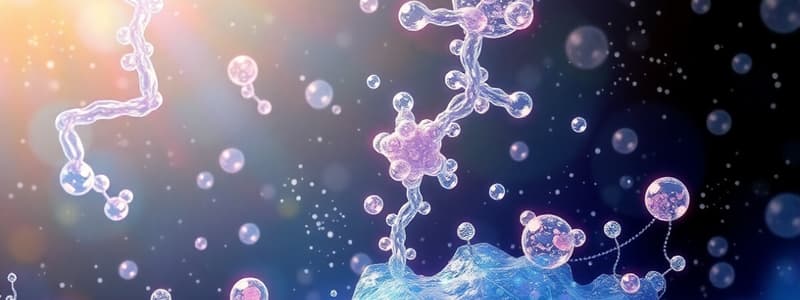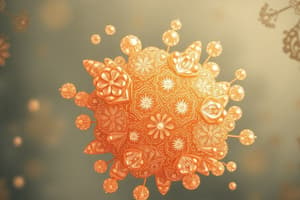Podcast
Questions and Answers
What is the classification of carbohydrates that yield more than 10 molecules of monosaccharides on hydrolysis?
What is the classification of carbohydrates that yield more than 10 molecules of monosaccharides on hydrolysis?
- Disaccharides
- Polysaccharides (correct)
- Oligosaccharides
- Monosaccharides
Which of the following options correctly defines an aldose?
Which of the following options correctly defines an aldose?
- A carbohydrate with two carbonyl groups
- A carbohydrate with three carbon atoms
- A carbohydrate with a ketone functional group
- A carbohydrate with an aldehyde functional group (correct)
Which monosaccharide serves as the major source of energy for red blood cells?
Which monosaccharide serves as the major source of energy for red blood cells?
- Glucose (correct)
- Fructose
- Mannose
- Galactose
Which type of carbohydrate cannot be hydrolyzed into simpler forms?
Which type of carbohydrate cannot be hydrolyzed into simpler forms?
Which of the following hexoses is primarily found in fruit juices and serves as an energy source for spermatozoa?
Which of the following hexoses is primarily found in fruit juices and serves as an energy source for spermatozoa?
What condition is associated with fructose accumulation?
What condition is associated with fructose accumulation?
Which of the following statements about galactose is TRUE?
Which of the following statements about galactose is TRUE?
What determines the number of possible isomers of a compound?
What determines the number of possible isomers of a compound?
Which carbon atom configuration designates a D-sugar?
Which carbon atom configuration designates a D-sugar?
Which type of isomerism involves compounds with the same structural formula but different spatial arrangements?
Which type of isomerism involves compounds with the same structural formula but different spatial arrangements?
Flashcards
Hereditary Fructose Intolerance
Hereditary Fructose Intolerance
A genetic disorder where the body has trouble breaking down fructose, leading to fructose buildup and complications like liver problems and low blood sugar.
Galactosemia
Galactosemia
A genetic disorder affecting galactose metabolism, resulting in galactose buildup and causing various health problems like jaundice, diarrhea and liver damage.
Isomers
Isomers
Different compounds with the same molecular formula but different arrangements of atoms.
Stereoisomers
Stereoisomers
Signup and view all the flashcards
Asymmetric carbon atom
Asymmetric carbon atom
Signup and view all the flashcards
Monosaccharides definition
Monosaccharides definition
Signup and view all the flashcards
Aldose
Aldose
Signup and view all the flashcards
Ketose
Ketose
Signup and view all the flashcards
Glucose function
Glucose function
Signup and view all the flashcards
Fructose function
Fructose function
Signup and view all the flashcards
Study Notes
Carbohydrates
- Carbohydrates are (CHO) are aldehyde or ketone derivatives of polyhydric alcohols or substances derived from them.
- Carbohydrates are sugar polymers.
- Carbohydrate = Carbon + Water
- General formula is Cn(H₂O)n or C₆H₁₂O₆
Classification
- Carbohydrates are classified according to the hydrolytic products as follows:
- Monosaccharides
- Disaccharides
- Oligosaccharides
- Polysaccharides
Monosaccharides
- Simplest groups of carbohydrates, cannot be further hydrolysed.
- Categorization is based on:
- Functional group (aldehyde or keto)
- Number of carbon atoms
Classification of Monosaccharides
| No. of C-Atoms | Aldoses | Ketoses |
|---|---|---|
| Trioses | Glycerose (or) Glyceraldehyde | Dihydroxyacetone |
| Tetroses | Erythrose | Erythrolose |
| Pentoses | Ribose, Xylose, Arabinose | Ribulose, Xylulose |
| Hexoses | Glucose, Galactose, Fructose, Mannose | |
| Heptoses | Glucoheptose, Galactoheptose | Pseudo heptulose |
- Aldose is a carbohydrate with aldehyde functionality.
- Ketose is a carbohydrate with ketone functionality.
- The smallest aldose in the human body is glyceraldehyde.
- The smallest ketose in the human body is dihydroxyacetone.
Pentose
- In DNA: Deoxyribose sugar
- In RNA: Ribose sugar
Hexoses
- Physiologically important hexoses are glucose, galactose, fructose, and mannose.
Isomerism
- Isomers are different compounds that have the same molecular formula but different structural or stearic formula.
- Stereoisomers: the order in which the atoms are joined is the same, but the molecules have a different spatial arrangement of the atoms and hence, different three-dimensional shapes.
- Enantiomers: mirror images of each other. For example, D- and L-glyceraldehyde.
- D-sugars: -OH group on the right side of the chiral carbons.
- L-sugars: -OH group on the left side of the chiral carbons.
- The formation of isomers is caused by the presence of asymmetric carbon atoms, i.e., carbon atoms attached to four different atoms.
- The number of possible isomers of a compound depends on the number of asymmetric carbon atoms (n) and is equal to 2ⁿ.
- All monosaccharides have asymmetric carbon atoms except dihydroxyacetone.
Alpha and Beta Isomers (Anomers)
- These are isomers differing in the configuration of -OH & -H on C1 in the cyclic structure.
- Cyclic structure of glucose is favored and accounts for most of its chemical properties.
- Stable ring structures of monosaccharides are similar to ring structures of either pyran or furan.
- 99% of glucose in solution is in the pyranose form.
- α-anomers have the -OH at C1 below the ring.
- β-anomers have the -OH at C1 above the ring.
Cyclic Structure of Fructose
- Fructose is a ketohexose.
- Forms a cyclic structure.
- Reacts the -OH on C-5 with the C=O on C-2.
Epimers
- These are isomers that differ only in the configuration about one carbon atom.
- The most important epimers of glucose are mannose and galactose.
- Mannose is formed by epimerization at carbon 2.
- Galactose is formed by epimerization at carbon 4.
Aldoses and Ketoses
- Depending on the presence of aldehyde or keto group in the sugar.
- Fructose contains a ketone group in position 2, whereas glucose has an aldehyde group in position 1.
Geometrical Isomers
- Two forms of geometrical isomers:
- Cis-isomer: identical atoms or groups present on the same side of the two carbon atoms in the molecule.
- Trans-isomer: identical atoms or groups are on two opposite sides of the two carbon atoms in the molecule
Sugar Derivatives
- Ester formation
- Sugar acids
- Sugar alcohols
- Amino sugars
- Deoxy sugars
Esterification
- Alcoholic groups of sugars react with acids to form esters.
- Biological esters are mainly those with phosphoric acid.
Sugar Acids
- Produced by oxidation of carbonyl carbon to a carboxylic of the last hydroxy carbon.
- Oxidation of both.
Sugar Alcohols
- The sugar is reduced to the corresponding alcohol.
- Examples:
- Glyceraldehyde → glycerol
- Dihydroxyacetone → glycerol
- Ribose → ribitol
- Glucose → sorbitol
- Galactose → galactitol
- Mannose → mannitol
- Fructose → mixture of sorbitol & mannitol (equal amounts)
Importance of Sugar Alcohols
- Used as sweeteners in the food industry as replacements for sucrose (table sugar).
- Not metabolized by oral bacteria, so they do not contribute to dental decay.
- Ribitol is part of vitamin B2 (riboflavin) structure.
Importance of Glucuronic acid
- Highly polar molecule.
- Incorporated into proteoglycans.
- Conjugated with bilirubin for solubility.
- Conjugated with certain drugs for solubility.
- Easily cleared from blood by excretion in urine.
Amino Sugars
- Amino group substitutes for a hydroxyl.
- Example: glucosamine
- Amino group can be acetylated (e.g., N-acetylglucosamine)
Amino Sugar Acid
- N-acetylneuraminate (NANA, sialic acid): Terminal residue in oligosaccharide chains of glycoproteins and glycosphingolipids.
- Imparts negative charge to glycoproteins.
Importance of sialic acid
- Structural component of terminal carbohydrate chains of mucoproteins.
- Increased in serum of tumor-bearing humans, can be used as a tumor marker.
Deoxy Sugars
- D-2-deoxyribose: Derived from D-ribose by deoxygenation at carbon-2. Present in DNA.
- L-fucose: Derived from L-galactose by deoxygenation at carbon-6. Located at the end of carbohydrate chains of mucoproteins.
- High levels in urine and blood of patients with diabetes, cancer, and other diseases.
Additional Information
- Which monosaccharide has no asymmetric carbon? Dihydroxyacetone.
- D-Glucose is based on the position of (OH) to the right at which carbon? Carbon 5.
- Which of the following is a ketose sugar? Fructose.
- Glucose and galactose are epimers. This means what? They differ only in the configuration about one carbon atom.
- Carbohydrates are made up of what elements? Carbon, hydrogen, and oxygen.
- What is the minimum number of carbons in a monosaccharide? 3.
- A carbohydrate found in DNA is? Deoxyribose.
Studying That Suits You
Use AI to generate personalized quizzes and flashcards to suit your learning preferences.



